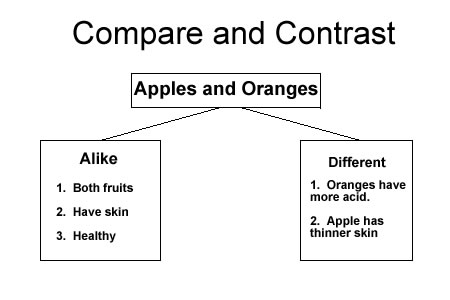Comparison and Contrasts text
Today I had learned the first day after the celebrating New Year's festival in the past.
Today I learned about Comparison and Contrasts text. The purpose of this text told me about a comparison is a similarities between two or more things and contrasts are differences between two or more things. Mostly, Authors used it when they wanted presenting opposite sides of an issue. You job as a reader was to determine what is being compared or contrasted , and the ways in which they were similar or different.
Today I got a lot of knowledge in the text. Well, I think this text was really important for the reader who wanted trying to understand a lot. And then, Teacher ordered the homework to me about procedure ( How to do or make somethings). I got a lot of ways and suggestion from teacher. It was a good time for me.
This is a bit of knowledge about Comparison and Contrasts text.
Compare and Contrast is a text structure or pattern of organization where the similarities and differences of two or more things are explored. It is important to remember that with the compare and contrast text structure the text should be discussing similarities and differences. If the text only discusses similarities, it is only comparing. Likewise, if it only discusses ways that the things are different, it is only contrasting. The text must do both to be considered compare and contrast.

Example: Apples and oranges are both fruits, which means that they have seeds inside of them. Each has a skin, but orange skins are thick and easy to peel. Apple skins are thinner and do not peel easily. Oranges also contain more acid than apples, but both fruits are delicious.
Identifying when the writer is comparing and contrasting is usually not difficult because the speaker will bounce back and forth between two subjects and this pattern is generally pretty easy to recognize. However, here are some signal words that may indicate that the text is written using the compare and contrast organizational pattern: like, unlike, both, neither, similar, and different.
Today I got a lot of knowledge in the text. Well, I think this text was really important for the reader who wanted trying to understand a lot. And then, Teacher ordered the homework to me about procedure ( How to do or make somethings). I got a lot of ways and suggestion from teacher. It was a good time for me.
Compare and Contrast is a text structure or pattern of organization where the similarities and differences of two or more things are explored. It is important to remember that with the compare and contrast text structure the text should be discussing similarities and differences. If the text only discusses similarities, it is only comparing. Likewise, if it only discusses ways that the things are different, it is only contrasting. The text must do both to be considered compare and contrast.

Example: Apples and oranges are both fruits, which means that they have seeds inside of them. Each has a skin, but orange skins are thick and easy to peel. Apple skins are thinner and do not peel easily. Oranges also contain more acid than apples, but both fruits are delicious.
Identifying when the writer is comparing and contrasting is usually not difficult because the speaker will bounce back and forth between two subjects and this pattern is generally pretty easy to recognize. However, here are some signal words that may indicate that the text is written using the compare and contrast organizational pattern: like, unlike, both, neither, similar, and different.
Thank You 02/01/14

No comments:
Post a Comment